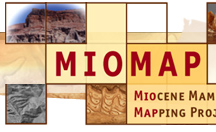EDUCATIONAL BENEFITS
The MIOMAP project
has produced the following educational benefits:
IB 286, Seminar
in Paleontology: Evolution of Cenozoic Biotic Provinces in Western North
America. Taught graduate students and advanced undergraduates techniques
of database design and analysis through experiential learning that featured
assembling background information for MIOMAP data entry, and using the
data to detect differences and similarities between various regions
during the Miocene.
IB 166, Evolutionary
Biogeography. Incorporated MIOMAP data and analytical techniques
into a series of course lectures.
IB 259, Advanced
Paleoecology: Effects of Cenozoic Climate Change on Biota. Taught
graduate students and advanced undergraduates the paleoclimatology principles
needed to conduct in depth analyses of how climate change might affect
ecological and evolutionary systems.
IB 297, Directed
Field Studies: Geoecology Along the Track of the Yellowstone Hotspot.
This course took 5 students (4 graduate, 1 undergraduate) from UCB
on a four-week field trip through the western United States to teach
them basic paleontologic field techniques and how to integrate geological
and ecological field research. The basic structure was to follow the
track of the Yellowstone Hotspot from its origin in southeastern Oregon
~16 million years ago, across the Snake River Plain, and into modern
Yellowstone Park. Along the way were a variety of hands-on field exercises
at MIOMAP localities that not only provided essential field information
for the MIOMAP project, but also featured interesting paleontological
and ecological problems for students to work on. The course was run
concurrently with a similar course offered out of Stanford University
(by Elizabeth Hadly), which brought along an additional instructor (Professor
Hadly) and six Stanford students.
GIS Training.
Three students (2 graduate and 1 undergraduate) received basic training
in ARC/INFO through classroom instruction arranged by the UC Museum
of Vertebrate Zoology and the Geographic Information Sciences Center.
Hands-on Research.
Aspects of the project have involved a minimum of 1 postdoc, 6 graduate
students, and 6 undergraduates. These students received hands-on training
in various aspects of specimen identification and description, field
techniques, database techniques and web authoring, presentation of research
results, and writing research papers and grant proposals. So far, two
dissertation projects (Davis and Hopkins) have been spin-offs of the
MIOMAP project and a third (Feranec) both utilizes and directly contributes
to it. Two undergraduate honors theses utilized MIOMAP.





